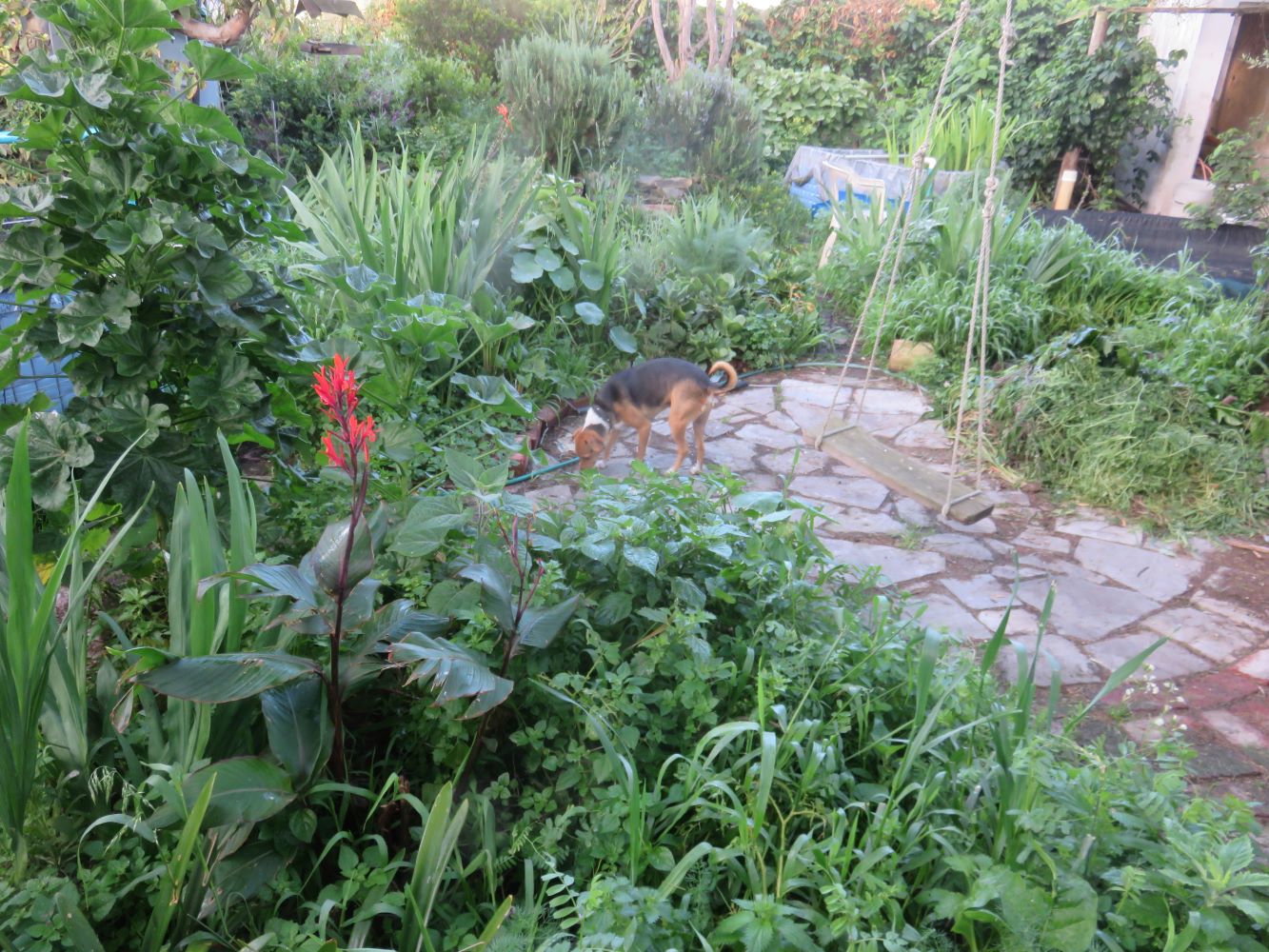Dear Reader, in this age of AI created content, please support with your goodwill someone who works harder to provide the human-made. Sign up in the righthand column or bottom of this page. You will receive my hand illustrated monthly newsletter RESTORE NATURE and access to the biodiversity garden design course as I write...and nothing else, I respect your time.
Pentagonal aerobic composter:
Maximizing composting space using pallets.
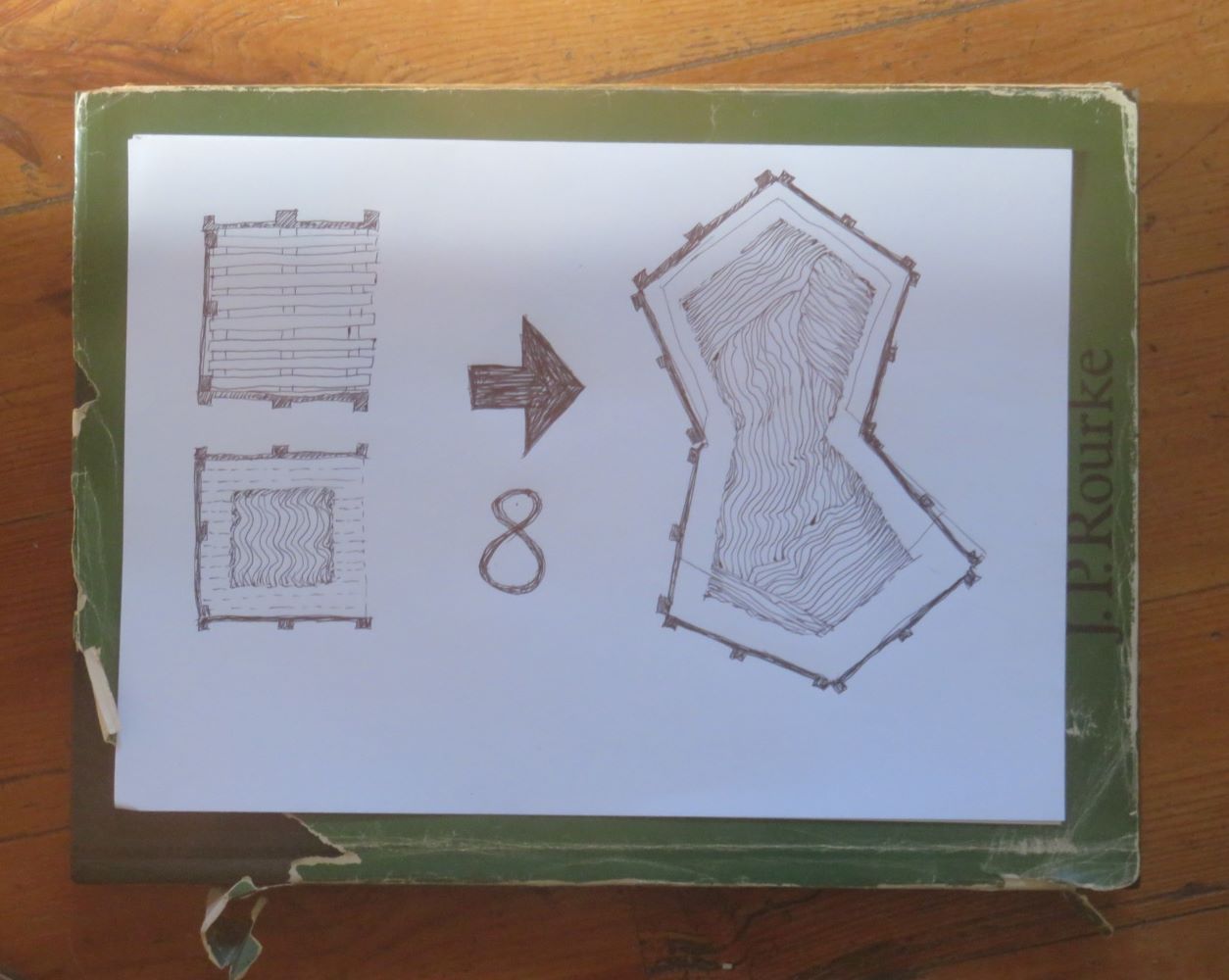 Using 8 pallets: The pentagonal composter has so much more space
Using 8 pallets: The pentagonal composter has so much more spaceWhy the composter size is important
I am concerned about my composter space because composting humanure is an essential part of the individual householder's efforts to sequester carbon naturally. For reasons laid out below, it is ideal to maximize space for humanure composting. What I had available were 8 old pallets, built into two cubic composting chambers, from my previous attempts at humanure composting.
There are many
ways of making organic compost and many kinds of containers one can
use, either ready made or DIY. However, when composting humanure, I support the world expert Joe Jenkins in believing a large volume is needed, because this means it can get hot enough and it can rest for a
longer, two years being optimal, to eliminate the threat of pathogens. This is especially necessary in cities where many people come together in a small space.
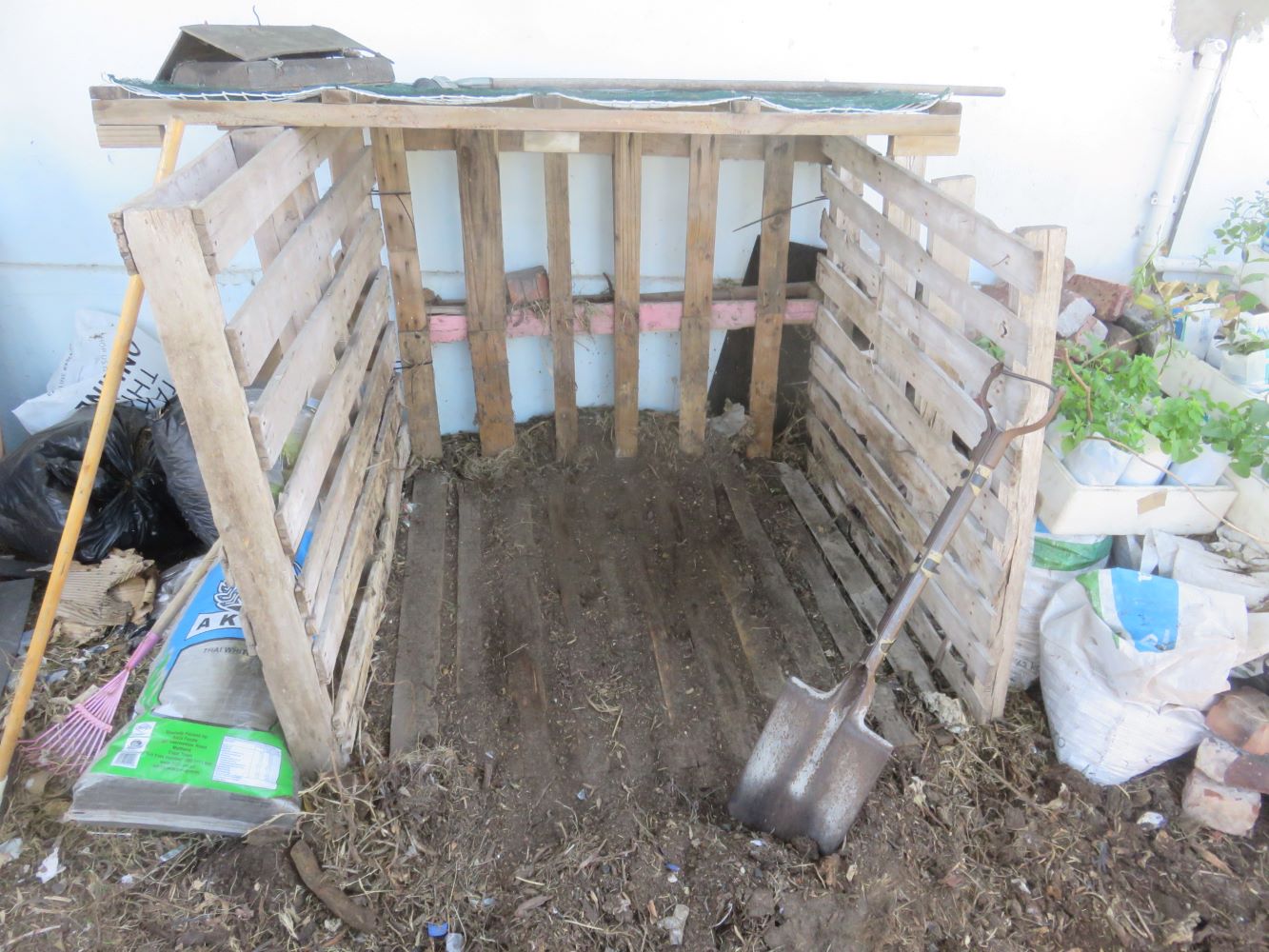 Our old cubic composter after being emptied.
Our old cubic composter after being emptied.Cautioning composters: neighbours and odors are often a problem.
We have composted humanure for many years in the past. Eventually we stopped because our neighbors complained and hinted darkly at the funny smells wafting over the wall. These smells could have been from the humanure buckets, in which case the smells would have lasted only while emptying, and before washing the buckets and covering the compost, all in all ten minutes at a time, once every two weeks, hardly a nuisance. Covering the humanure with straw or dried grass quickly shuts off the odor completely. However I rather think the smells came from my liquid green manure, or 'Jauche' in German. It uses an anaerobic fermentation process, and it is from a German source that I learned to brew this 'beer for plants'. Jauche consists only of fermented grass and weeds, but it smells toe curlingly potent, very similar to wet cow dung, but stronger, as it still contains all the nutrients in the plants because they have not been absorbed by the cow. The smell of green manure wafts around unless you close the buckets where you are brewing it, and it sticks to everything, including the hands, for days.
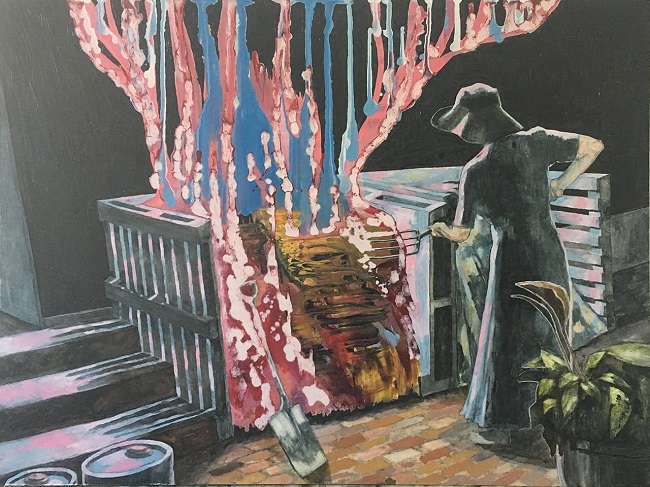 This is a perceptive picture of me turning the compost whose constellations of microscopic beings maintain life. Its painted by the genius and visionary, Lizza Littlewort.
This is a perceptive picture of me turning the compost whose constellations of microscopic beings maintain life. Its painted by the genius and visionary, Lizza Littlewort.Whatever caused the smells, it put the fear of pestilence and disease into our neighbors, and we suspended our humanure composting.
I have so regretted flushing all those nutrients down the waste pipes of our home in the last few months. Subsequent to this incident I met a dedicated humanure composter. Talking to her gave me courage to start again, and a few pointers as to where we may have gone wrong. For example, it is important to produce no odors.
She uses a bucket and commode system with sawdust, and
everything goes into the bucket, which must then be emptied often. We
used to separate off the urine which has a much larger volume, and so the bucket only had to be emptied once
a week or so. Though this was less work, it meant there was a bad smell when we emptied the
buckets, as anaerobic processes were well under way by
then. We also did not use sawdust, which is apparently so
absorbent that there is no odor, despite all the
urine and the wetness of the mix.We used a combination of newspaper covering the humanure and what I called 'fines' or very fine sweepings from under the Acacia tree. It consists of tiny dry leaves a few millimeters long. It does not prevent odor as effectively as fine sawdust.
For composting the dedicated composter does not use a typical large circular Joe Jenkins style composter. She uses commercial composters, the conical plastic type, I think she has three, to be able to store the compost for a longer time.
I prefer to use a large aerobic composter so that the heat can really build up, and the composter takes two years to fill. Once filled it can just sit for that period while the other bin is filling. I wondered how I could increase the heap size most easily using available materials.
Although the composting process
is essentially aerobic, or hot composting, the heap is not turned during the two years, to avoid exposure to pathogens in the decomposing feces. After this amount of time the pathogen presence should be insignificant. The greatest danger is in infecting other people, especially children and seniors.
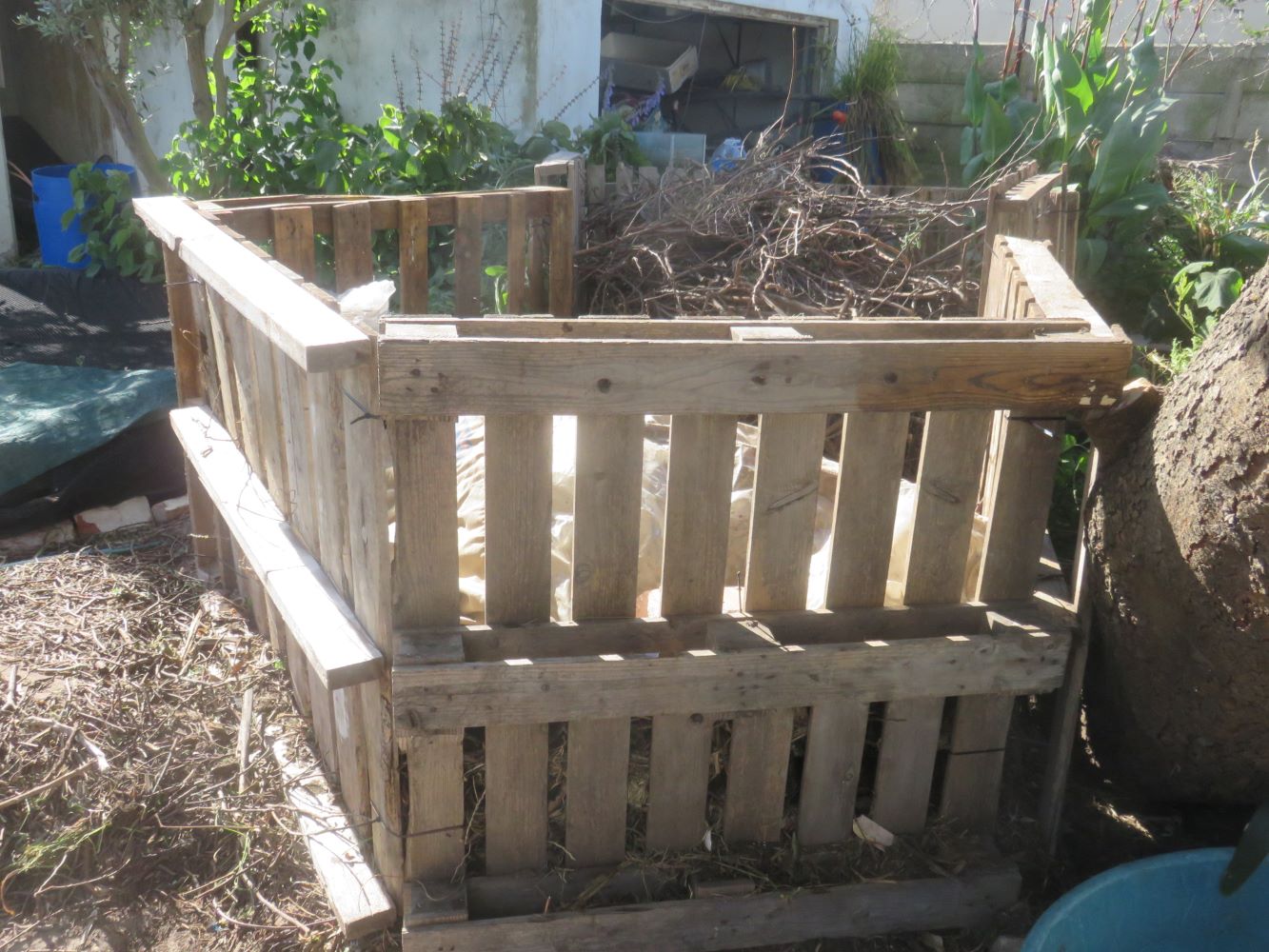 The new composter based on pentagons.
The new composter based on pentagons.Benefits of a pentagonal composter
We built cubic composting chambers long ago out of pallets tied together with cable ties. They have stood in many locations in the garden over the years, but this is the first time I've tried a new configuration. Instead of building cubic shapes with the pallets, I decided to experiment with a pentagon. I worked out that if I built two touching pentagons sharing an open side, ideal for worm migration, and standing on the bare earth, they would need the same number of pallets used in my old arrangement of two cubic chambers with open fronts and tops, and a pallet floor. The pallet floor was to ensure aeration from below, but bioturbation generally fills up the area below the pallet anyway.
Changing to pentagons vastly increases the volume of the compost heaps as you can deduce from the diagram. The plan area is larger, and they can also be piled higher. Their girth is that much greater that the area that should probably get really hot in the center of the heap is much larger. I've marked the 'hot' area with wavy lines in the diagrams.
Two
cubic chambers open at the front, can be built with just five pallets.
If you have eight pallets almost any eight sided shape is an improvement
on two cubes, even a long rectangle with three pallets a side has a
better wall to volume ratio. However, the center of the pentagon is an
arm reach from the edge. If all the walls are closed and you have shapes
with a larger diameter, you may not be able to drop the fresh material
in the center. So be careful of the composter getting too big unless you're a bodybuilder.
The safe way to fill the composter
The importance of being able to reach the center of the heap is that the heap is built up with non fecal dry organic material (like grass or straw) around the edge, and the humanure in a hollow in the middle. After emptying the buckets, the contents is quickly covered with more organic material, like a lid, so that there is an envelope or box around the sides and top of the humanure. This envelope of organic material keeps the heat in, prevents fly access, blocks off and absorbs smells, and prevents any exposure of human feces on the sides or top of the heap. When making the first manure deposit, it must also rest on a layer of dry organic material. Thereafter, each new deposit will rest on material that has been decomposing for a longer time and is full of microbes that will quickly attack the new material and feed off it.
Thus the humanure remains entirely shut in till it is thoroughly digested by the composting microbes and represent no threat to health.
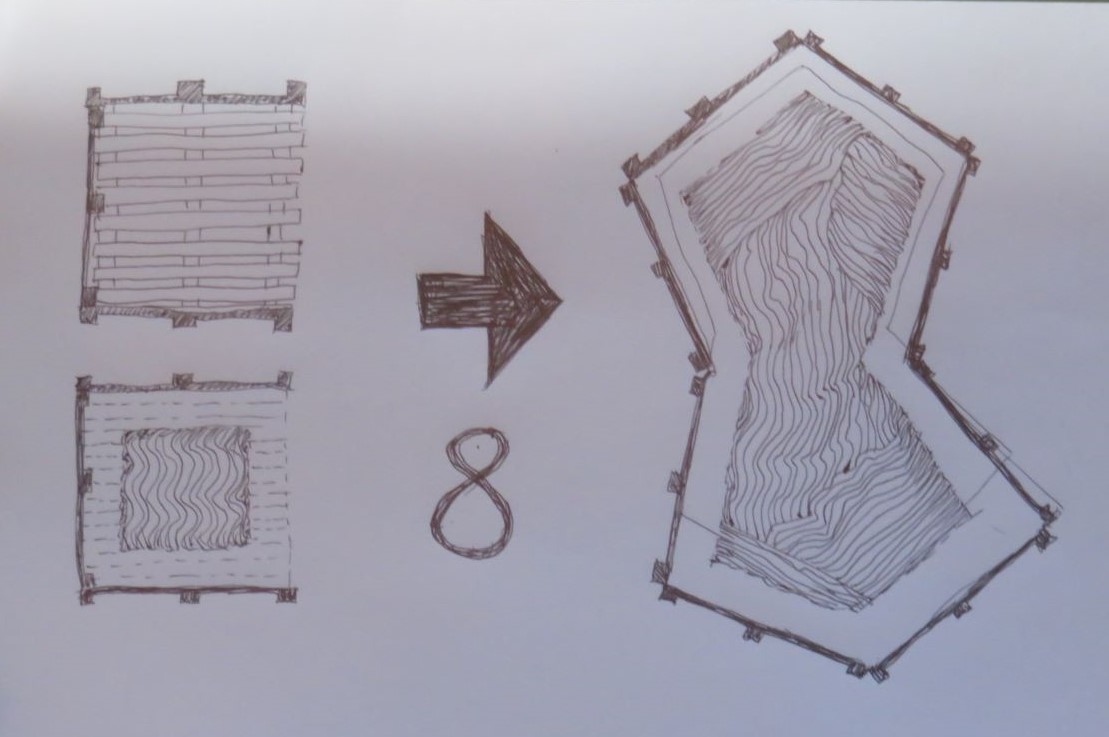 The hot areas in the heaps are shaded
The hot areas in the heaps are shadedThe composters have a wall of about fifteen to twenty centimeters around the edge which never decomposes, because it dries out quickly, is cooler and contains fewer nutrients than the centre. In the cubic composter this un-decomposed material almost dominates the composted manure in quantity. It is better to have a more thorough processing, with more heat, and for that you need more volume at the heart of the heap. The heat will get rid of pathogens as well as weed and especially grass seeds, as we use grass for covering. If the pentagons also have a twenty centimeter wall of undecomposed material, the hot heart of the composter is huge by comparison to the cube, leading to more processing and sanitation.
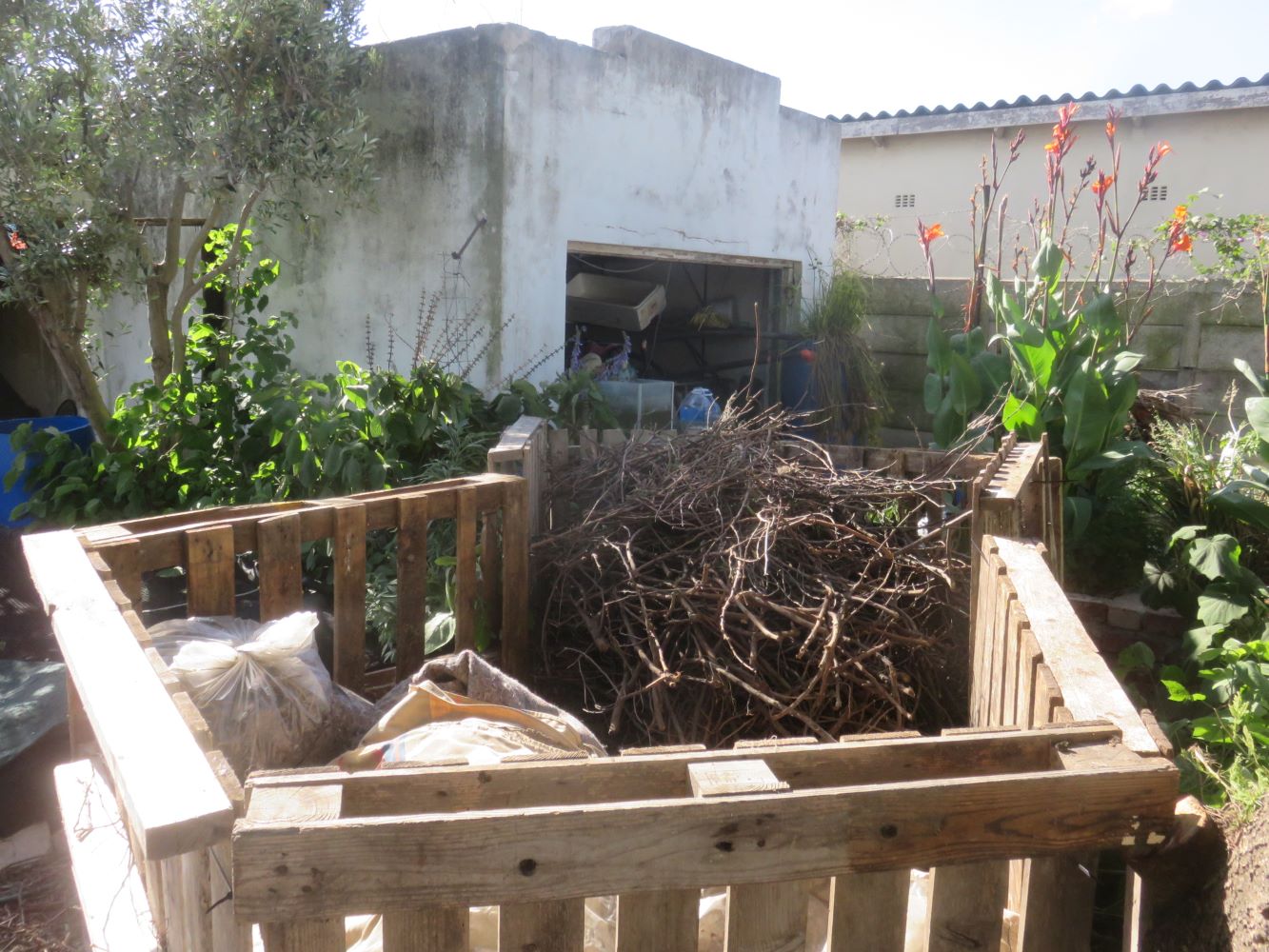 The new composter chambers are very spacious.
The new composter chambers are very spacious.Constructing the composter
In an unoccupied area of the garden, I measured the pentagonal shapes out, and drove stakes into the ground at the future corners. Then I emptied the old cubic composters and took them apart and moved them to the new location. After tying the cable ties tight I noticed that the new structure is a lot more wind stable. It was a typical gusty Cape summer day and they didn't move at all, whereas the old cubic ones were rocking and vibrating a bit. I'm so pleased as this bodes well for their stability over the coming seasons.
The composter in different climates
In our climate, aeration is not difficult to provide. The material tends
to remain dry, and the problem is keeping the heap damp enough to
decompose. I have a two cubic meter heap of grass in another
location, which refused to decompose till I began to wet it daily
with about five liters of water and urine, and that seems to be
working. To keep this pentagonal heap damp enough, I intend to
line the pallets with plastic from top to bottom. Another purpose of the liner will be to prevent fly access, so that we don't start breeding them and cause offense in the neighborhood.
This lining with plastic may be counter
productive in wet cold climates, and could lead to a very anaerobic
compost heap, with bad smells and a lot of methane production. In
cold wet climates keeping the heap dry and well aerated is more problematic. The composter can be roofed over, to keep the rain out, and let oxygen in.
Fitting this into our lives
At the moment one of the chambers is full of twigs as we we have cut down a lot of our thorn tree. It will be used for mulch when areas of the garden need it, as Vachellia (used to be Acacia) karroo or 'sweet thorn' is a nitrogen fixer. The thorny branches also deter scratching birds and other digging animals, and snails. Placed on paths, the smaller sticks are slowly ground into the earth by (booted) feet. The other chamber contains all the remaining compost from the cubic composter, and a massive heap of weeds I pulled up two weeks ago and about three bags of dry material. You can see that there is still a lot of room in the composter. I watered it and covered it with a tarp to keep it from drying out. I have sourced toxin free sawdust from a local mill and we can collect this week and start composting humanure again.
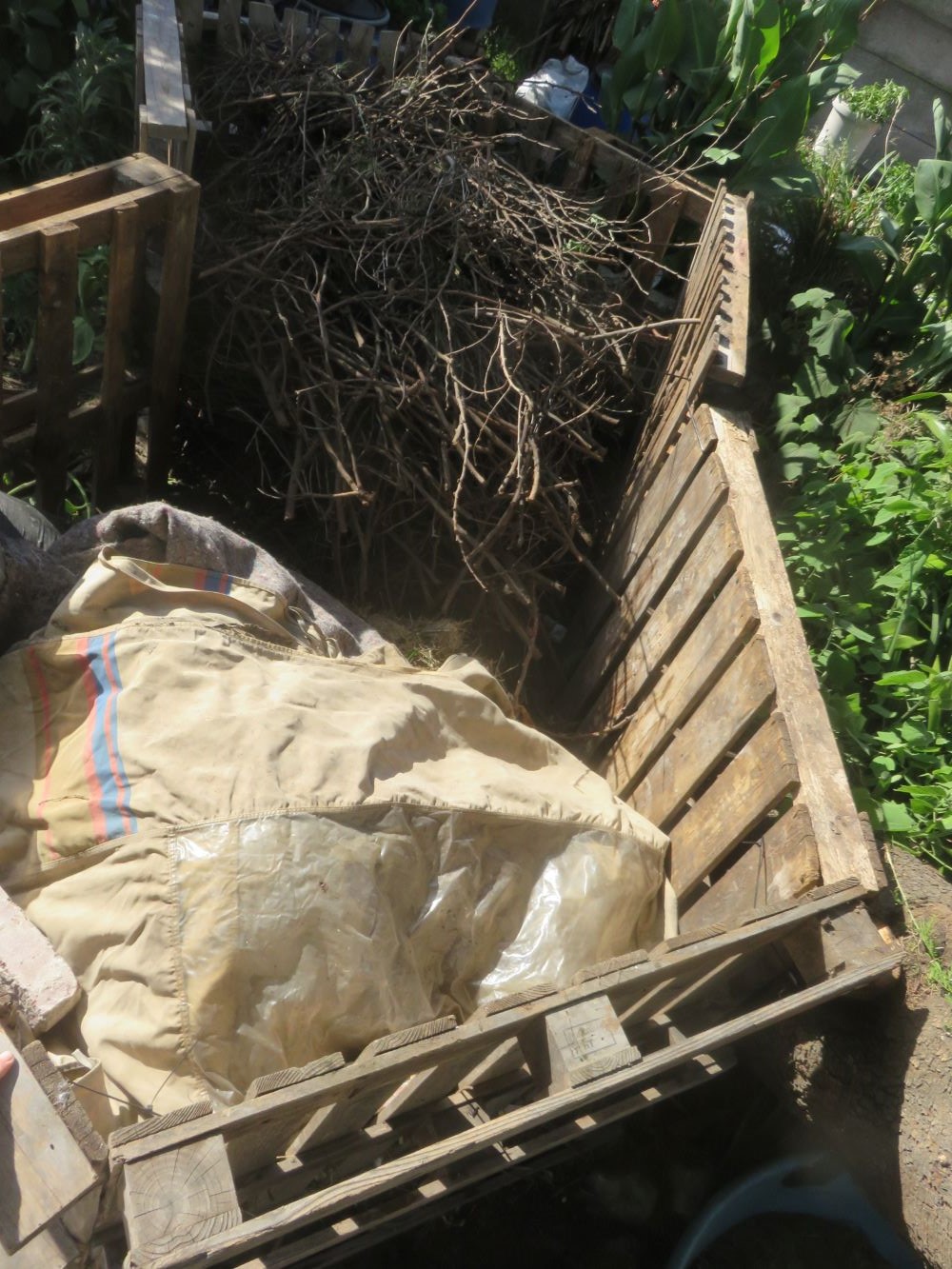 tarp cover to keep moisture tarp cover to keep moisture |
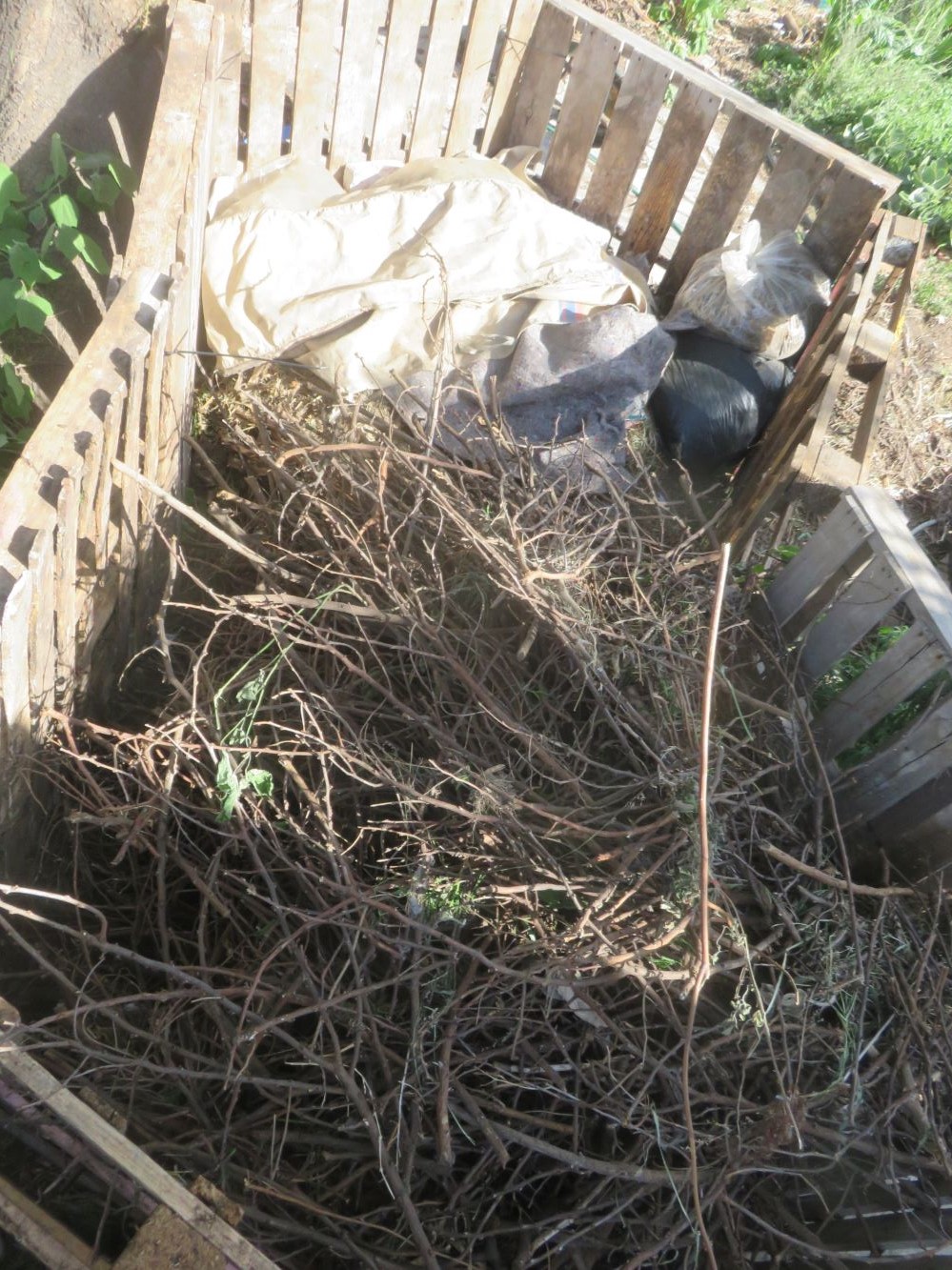 temporary mulch storage bin temporary mulch storage bin |
I compost humanure because I'm mad about self sufficiency, and my garden, but also in order to sequester carbon in my garden soil. The rich compost will allow plants to thrive and sequester carbon during photosynthesis, releasing it deep below the ground to become part of the humic complexes in the soil. The idea that composting can help sequester carbon is found in much permaculture writing and has been confirmed by Whendee Silver's research at UC Berkeley. The deeper the roots can discharge the carbon into the soil, the better, so trees bury the carbon deeper. I'm slowly turning my garden from a shrub based food forest into a tree based one. In a few years this place will be thick with fruit and berry trees and I hope to be living a carbon neutral life, if not a carbon negative one.
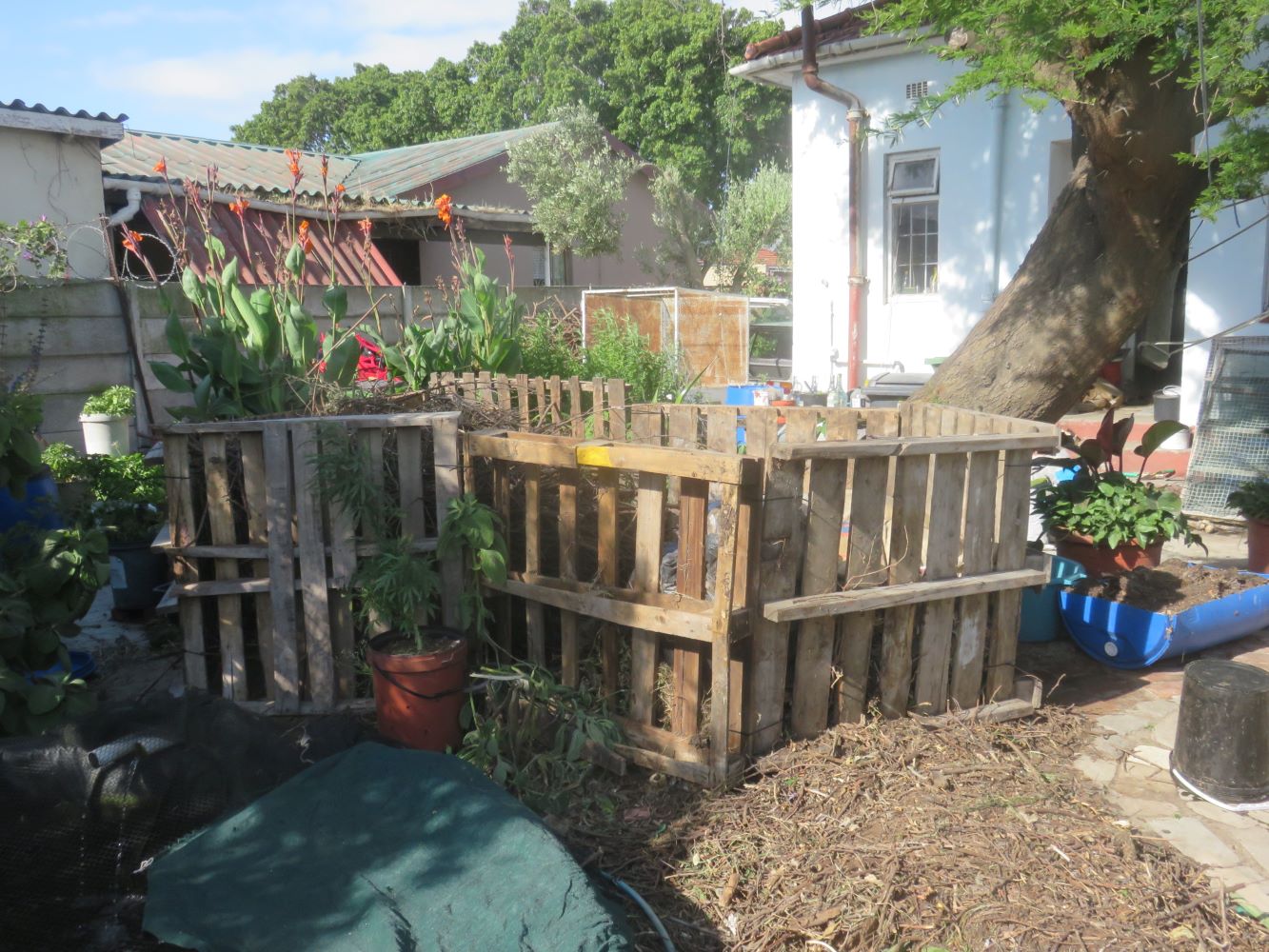 Our large humanure composter will be essential to our activism, and safer for everyone.
Our large humanure composter will be essential to our activism, and safer for everyone.------
home page for lots of links to articles on natural gardening and environmental issues
------
------
describing our old system of humanure hacks
------
Restore Nature Newsletter
I've been writing for four years now and I would love to hear from you
Please let me know if you have any questions, comments or stories to share on gardening, permaculture, regenerative agriculture, food forests, natural gardening, do nothing gardening, observations about pests and diseases, foraging, dealing with and using weeds constructively, composting and going offgrid.
SEARCH
Order the Kindle E-book for the SPECIAL PRICE of only
Prices valid till 30.09.2023
Recent Articles
-
garden for life is a blog about saving the earth one garden at a time
Apr 18, 25 01:18 PM
The garden for life blog has short articles on gardening for biodiversity with native plants and regenerating soil for climate amelioration and nutritious food -
Cape Flats Sand Fynbos, Cape Town's most endangered native vegetation!
Apr 18, 25 10:36 AM
Cape Flats Sand Fynbos, a vegetation type found in the super diverse Cape Fynbos region is threatened by Cape Town's urban development and invasive alien plants -
Geography Research Task
Jan 31, 25 11:37 PM
To whom it may concern My name is Tanyaradzwa Madziwa and I am a matric student at Springfield Convent School. As part of our geography syllabus for this
"How to start a profitable worm business on a shoestring budget
Order a printed copy from "Amazon" at the SPECIAL PRICE of only
or a digital version from the "Kindle" store at the SPECIAL PRICE of only
Prices valid till 30.09.2023

